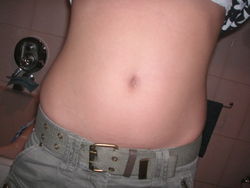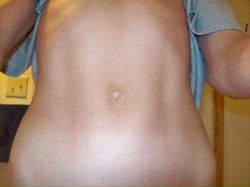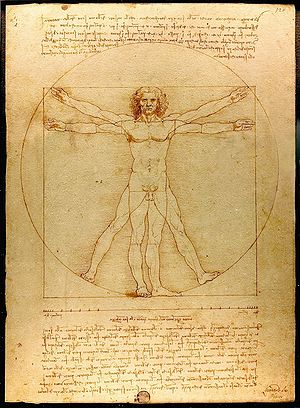Navel
| Navel | |
|---|---|
 |
|
| Human "innie" navel | |
 |
|
| Human "outie" navel | |
| Latin | umbilicus |
The navel (clinically known as the umbilicus, also known as the belly button) is a scar on the abdomen, caused when the umbilical cord is removed from a newborn baby. All placental mammals have a navel. It is fairly conspicuous in humans.
In humans, the scar can appear as a depression (often referred to colloquially as an innie) or as a protrusion (outie). Although they can be separated into these two categories, navels actually vary quite widely among people in terms of size, shape, depth/length, and overall appearance. As navels are scars, and not in any way defined by genetics, they can serve as a way of distinguishing between identical twins in the absence of other identifiable marks.
Contents |
Human anatomy
The umbilicus is an important mark on the abdomen since its position is relatively consistent among humans. The skin around the waist at the level of the umbilicus is supported by the tenth thoracic spinal nerve (T10 dermatome). The umbilicus itself lies at the level between L3/L4 vertebrae.

The reason for the occurrence of an outie is extra skin left from the umbilical cord or umbilical hernias, although a child with an umbilical hernia will not necessarily develop an outie. As well as the visible depression on a person's abdomen, the underlying abdominal-muscle layers also present a concavity; thinness at this point contributes to a relative structural weakness, making it susceptible to hernia. During pregnancy, the uterus presses the navel of the pregnant woman outward. It usually retracts after birth.
The umbilicus is also used to visually separate the abdomen into quadrants. The navel comes in the center of the circle enclosing the spread-eagle figure in Leonardo da Vinci's Vitruvian Man, his famous drawing on human proportions. This illustrates the principle that in the shift between the spread-eagle pose and the straight pose, the apparent center of the figure seems to move, but in reality, the navel of the figure, which is the true center of gravity, remains motionless.
Some people have a smooth indentation instead of an "innie" or "outie", usually due to surgery for umbilical hernia, gastroschisis, or tummy tuck. Overweight individuals have larger belly buttons on average than those of normal weight.
Fashion

Fashion sometimes exploits the navel through clothing that leaves part of the lower abdomen (i.e. the midriff) bare, a usage that is much more common for women than for men. Displaying a bare navel has been a taboo in certain Western cultures: for example, in the 1960s, Barbara Eden was not allowed to show her navel on the TV show I Dream of Jeannie. But it is now generally considered acceptable in Western culture.
The modern trend of exposing the navel has usually been confined to women, aside from a male belly-button shirt fad in 1980s fashion. While the West was more resistant to midriff-baring dresses until the 1980s, it has always been a fashion in Indian women's attire.[1] Indian women and especially those from Southern India have traditionally worn saris that bare the midriff and the navel.[2][3] In Indian culture, exposure of the navel is not considered a taboo and has, in fact, long been accepted as a graceful identifying mark of a woman.[1] A dimpled navel is considered a special asset of any prospective bride especially amongst South Indian women and an important quality of any budding Bollywood actress. Other Indian communities that accept navel exposure include the Rajasthanis and Gujaratis, whose women leave the midriff exposed while wearing short cholis with traditional gypsy skirts. However, these women cover their heads with a 'chador' and even cover their faces in front of strangers, which lends credence to the belief that navel-baring in India has a symbolic, almost mystical, association with birth and life and that the display is meant to emphasize the centrality of nature in the nurture role.[4] Along with the acceptance of navel display in Western societies, navel piercing is becoming more common among young women. Shorter garments that expose navels may also be worn to expose stomach/navel tattoos.
Sexuality
The navel's transformation from a vestigial fetal feeding tube to an erotic appendage can be ascertained from the attention it gets, ranging from a partner's casual stares to more intimate finger prodding. Navels can be the focus of sexual fetishism, especially among men. Belly button fetishism includes the acts of fingering, licking, tickling, or torturing (with a sharp object) the soft flesh of the navel cavity. While cleavage of the breasts is certainly meant to display feminine charms and has a risqué, "turn-on" appeal, a navel can also be considered an object of sexual appeal.
In the Song of Solomon, a book in the Hebrew Bible, there are allusions to exotic things in nature, with frequent interweaving of nature with erotic imagery. The navel figures in Solomon's lavish praise of his love, thus: "thy navel is like a round goblet, which wanteth not liquor"(7:2).[5]
Aki Sinkkonen of the University of Helsinki has suggested that navels are used to attract potential mates and is pursuing further research on this subject. His hypothesis "makes a lot of biological sense," according to Gerald Weissmann of the New York University School of Medicine.[6]
See also
- Abdominal hair
- Granuloma
- Navel fetishism
- Navel lint
- Omphalos
- Omphaloskepsis
- Umbilical hernia
- Umbilicoplasty or belly button surgery
References
- ↑ 1.0 1.1 Banerjee, Mukulika & Miller, Daniel (2003) The Sari. Oxford; New York: Berg ISBN 1859737323
- ↑ Alkazi, Roshan (1983) Ancient Indian Costume. New Delhi: Art Heritage
- ↑ Ghurye (1951) Indian Costume. Bombay: Popular Book Depot
- ↑ Beck, Brenda (1976) "The Symbolic Merger of Body, Space, and Cosmos in Hindu Tamil Nadu" in: Contributions to Indian Sociology; 10(2): 213-43.
- ↑ However this may be a euphemistic reference to the pudendum.
- ↑ Marshall, Jessica. "Belly Button Beauty Cues Potential Mates". Discover News. http://dsc.discovery.com/news/2009/01/30/belly-button-beauty.html. Retrieved 2009-01-31.
|
||||||||||||||||||||||